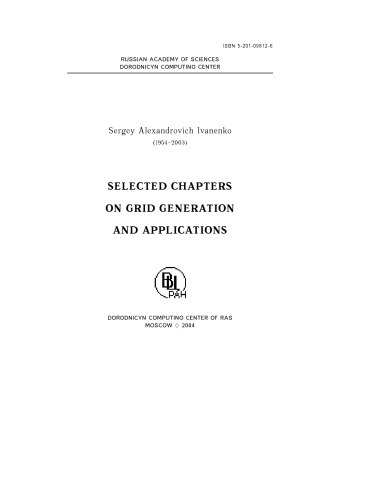

Most ebook files are in PDF format, so you can easily read them using various software such as Foxit Reader or directly on the Google Chrome browser.
Some ebook files are released by publishers in other formats such as .awz, .mobi, .epub, .fb2, etc. You may need to install specific software to read these formats on mobile/PC, such as Calibre.
Please read the tutorial at this link: https://ebookbell.com/faq
We offer FREE conversion to the popular formats you request; however, this may take some time. Therefore, right after payment, please email us, and we will try to provide the service as quickly as possible.
For some exceptional file formats or broken links (if any), please refrain from opening any disputes. Instead, email us first, and we will try to assist within a maximum of 6 hours.
EbookBell Team

4.8
44 reviews
ISBN 10: 5201098126
Author: Ivanenko S A
Boris N. Azarenok Grid generation algorithms in plane, surface, and space are considered within the frame of a general approach. The theory of the harmonic mappings is set forth in the context of using to the mesh construction problem. This theory is the basis for the numerical algorithms. The problem of constructing invertible mapping at the discrete level is considered. The conditions, being a discrete analogy of positivity of the Jacobian of a mapping, are used to provide invertibility of the grid cells in cases of meshes in plane, surface, and space. The algorithms possess the barrier property preventing cells from degenerating in the course of mesh smoothing. The problem of adaptive mesh generation is formulated by means of minimizing the energy density functional written on the surface (in the 3D case on the hyper-surface) of the graph of the adapted function. The use of the universal variational functionals allows mesh generation with any prescribed cell shape form. Results of calculations, illustrating capability of the algorithms, are presented
1. One-dimensional grid generation for numerical partial differential equations
1.1 Transformation of independent variables
1.2 Equidistribution principle
1.3 Nonstationary problems
1.4 Finite difference method
1.5 Finite element method
1.6 Finite Volume Method
1.6.1 Generalized formulation 1
1.6.2 Generalized formulation 2
1.6.3 Godunov’s theorem
2. One-dimensional grid generation: error estimates
2.1 A posteriori error estimates
2.2 A priori error estimates: minimization of approximation error
2.2.1 Problem formulation
2.2.2 Interpolation error
2.3 C. de Boor’s algorithm
2.4 One-dimensional harmonic mappings
3. Nondegenerate two-dimensional grids
3.1 Topological background
3.2 Two-dimensional structured (regular) grids
3.3 Discrete analog of the Jacobian positiveness
3.4 Unstructured (irregular) two-dimensional meshes
4. Barrier methods in two-dimensions
4.1 Planar harmonic grid generation
4.2 Equations for harmonic grid generation
4.3 The use of Poisson equations
4.4 Variational approach
4.5 Minimization of the functional
5. Adaptive-harmonic grid generation
5.1 Harmonic maps between surfaces
5.1.1 Theory of harmonic maps
5.1.2 Examples of non-homeomorphic harmonic maps
5.1.3 Derivation of governing equations
5.2 Construction of two-dimensional adaptive-harmonic structured grids by solving Euler equations
5.2.1 Derivation of equations
5.2.2 Numerical implementation
5.3 Variational barrier method for two-dimensional adaptive-harmonic grid generation
5.3.1 Problem formulation
5.3.2 Approximation of the functional
5.3.3 Minimization of the functional
5.3.4 Derivation of computational formulas
6. Adaptive-harmonic surface grid generation
6.1 Finite-difference adaptive-harmonic surface grid generator
6.1.1 Derivation of equations
6.1.2 Numerical implementation
6.2 Variational barrier method
6.2.1 Problem formulation
6.2.2 Approximation of functional
6.2.3 Minimization of functional
6.2.4 Derivation of computational formulas
6.3 Adaptation to curvature of surface
6.4 Example of nonuniqueness in grid generation on surface
7. Adaptive-harmonic three-dimensional grid generation
7.1 Three-dimensional regular grids
7.1.1 Derivation of equations
lz 20 - split-page notes for chapters 13-16
ncgr chapters
r selected graph
r selected generalist or specialist
r selected generalist
r selected characteristics
Tags: Ivanenko S A, chapters, grid